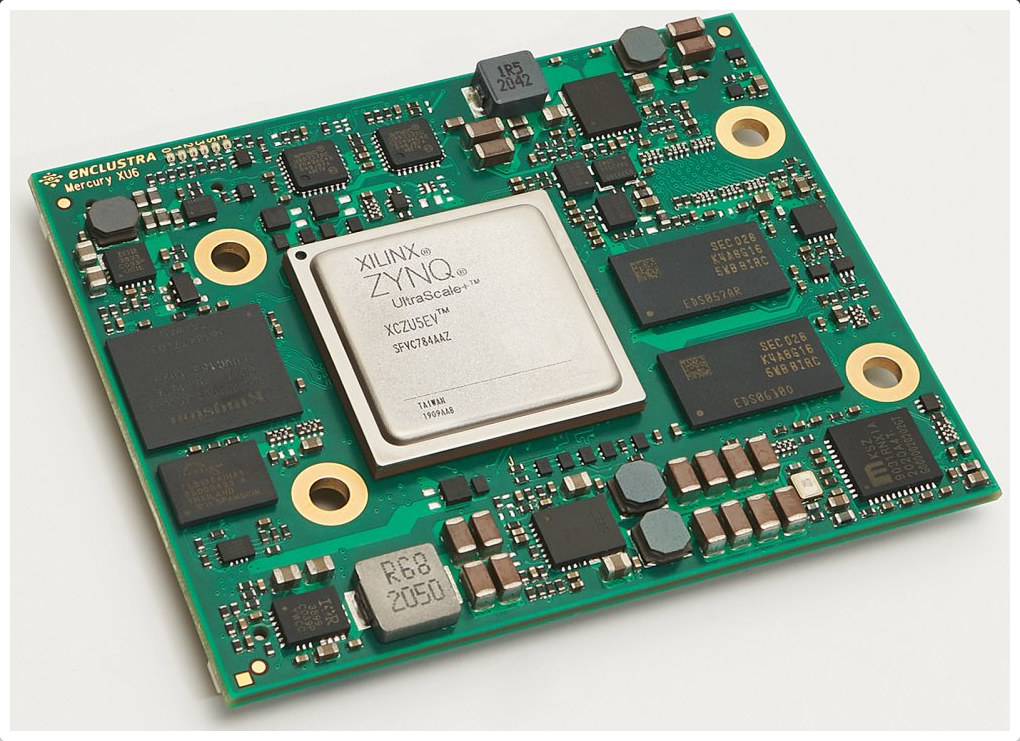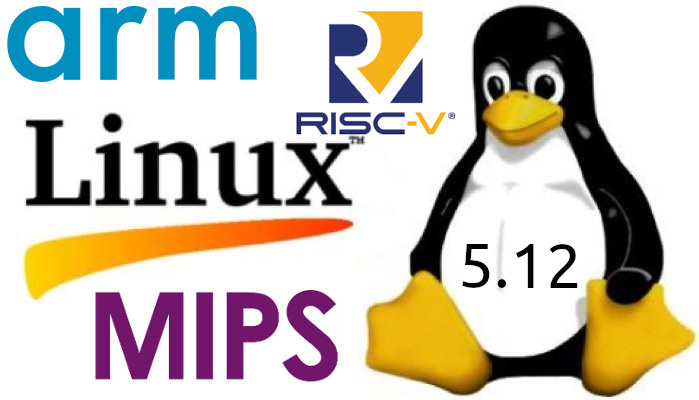Enclustra, a company headquartered in Switzerland specializing in FPGA solutions, has recently announced the launch of the Mercury+ XU6 system-on-module based on Xilinx Zynq UltraScale+ MPSoC. The module is optimized for I/O-intensive applications with up to 294 user I/Os, up to eight 6/12.5 Gbps multi-gigabit transceivers, and available with six different variants of Xilinx MPSoC. The company also offers Mercury+ ST1 and PE1 baseboards for evaluation and early software development. Mercury+ XU6 SoM Key features and specifications: SoC – Xilinx Zynq Ultrascale+ MPSoC (ZU2CG, ZU2EG, ZU3EG, ZU4CG, ZU4EV, or ZU5EV) with: CPU ARM dual-/quad-core Cortex-A53 processor up to 1333 MHz ARM dual-core Cortex-R5 up to 533 MHz GPU – Mali-400MP2 GPU (only for EG/EV variants) Video Codecs – H.264 / H.265 Video Codec (only for EV variants) FPGA fabric – Up to 256,000 system logic cells System Memory – Up to 8 GB DDR4 ECC SDRAM (PS side) Storage – […]
Xilinx Introduces Kria K26 SoM and vision AI devkit based on Zynq Ultrascale+ XCK26 FPGA MPSoC
Silicon vendors will usually focus on chip design, and provide an expensive evaluation kit to early customers, leaving the design of cost-optimized boards and system-on-modules to embedded systems companies. But Xilinx has decided to enter the latter market with the Kria portfolio of adaptive system-on-modules (SOMs) and production-ready small form factor embedded boards starting with Kria K26 SoM powered by Zynq UltraScale+ XCK26 FPGA MPSoC with a quad-core Arm Cortex-A53 processor, up to 250 thousand logic cells, and a H.264/265 video codec designed for Edge AI applications, as well as computer vision development kit. Kria K26 System-on-Module Kria K26 module specifications: MPSoC – Xilinx Zynq Ultrascale+ custom-built XCK26 with quad-core Arm Cortex-A53 processor up to 1.5GHz, dual-core Arm Cortex-R5F real-time processor up to 600MHz, Mali-400 MP2 GPU up to 667MHz, 4Kp60 VPU, 26.6Mb On-Chip SRAM, 256K logic cells, 1,248 DSP slices System Memory – 4GB 64-bit DDR4 (non-ECC) Storage – […]
Linux 5.12 – Main Changes, Arm, MIPS and RISC-V Architectures
Linux 5.12 release was expected last Sunday, but Linus Torvalds decided to release one more release candidate, namely Linux 5.12-RC8, to “make sure things are all settled down“, so the latest Linux kernel is now expected this weekend. Tihs should not yield any significant changes, so we can check what’s new in Linux 5.12, notably with regards to Arm, MIPS, and RISC-V architectures often used in SoC’s found in embedded systems. Around two months ago, the release of Linux 5.11 added support for Intel’s software guard extensions (SGX) and Platform Monitoring Technology (PMT), AMD “Van Gogh” and “Dimgrey cavefish” graphics processors, MIPI I3C host controller interfaces, and much more. Some interesting changes in Linux 5.12 include: Added support for ACRN hypervisor designed for IoT & embedded devices Added support for Playstation DualSense & Nintendo 64 game controllers, as well as Nintendo 64 data cartridges Dynamic thermal power management via a […]
Linux 5.11 Release – Main Changes, Arm, MIPS & RISC-V Architectures
Linus Torvalds has released Linux 5.11 just in time for… “Valentine’s Day”: Nothing unexpected or particularly scary happened this week, so here we are – with 5.11 tagged and pushed out. In fact, it’s a smaller-than-average set of commits from rc7 to final, which makes me happy. And I already have several pull requests lined up for tomorrow, so we’re all set for the merge window to start. But in the meantime – and yes, I know it’s Valentine’s Day here in the US – maybe give this release a good testing before you go back and play with development kernels. All right? Because I’m sure your SO will understand. Linus Last time around, Linux 5.10 was an LTS release that added EXT-4 performance enhancements, improved post-Spectre performance, as well as the enablement of BCM2711 (Raspberry Pi 4) display pipeline, among other many changes. Some of the notable changes in […]
FPGA powered Corazon-AI gateway supports up to 8 IP cameras for video analytics
Earlier this year, we covered some video analytics solutions based on AAEON UP Xtreme Edge embedded computer combining an Intel Whiskey Lake processor with Intel Movidius Myriad X AI accelerator modules, as well as video management & analytics software solutions from Milestones & SAIMOS, or aotu.ai BrainFrame. iWave Systems has now introduced a similar solution with Corazon-AI gateway capable of handling up to 8 IP cameras in real-time, but instead of relying on AI accelerators, the company leverages Xilinx Zynq Ultrascale+ Arm Cortex-A53/R5 FPGA MPSoC for AI inference. Corazon-AI gateway specifications: SoC – Xilinz Zynq Ultrascale+ ZU2, ZU3, ZU4 or ZU5 MPSoC Processing System (PS) Quad/Dual Arm Cortex-A53 @ 1.5GHz, dual Cortex-R5 @ 600MHz Arm Mali-400MP2 GPU @ 677MHz H.264/H.265 Video Encoder/Decoder Programming Logic (PL) Up to 256K Logic cells PL GTH Transceivers x 4 @ 12.5 Gbps System Memory 64bit, 2GB DDR4 with ECC for PS (upgradable) 32bit, 1GB […]
Xilinx Zynq UltraScale+ ZU19EG MPSoC Devkit Offers HDMI 2.0, 10GbE, High-Speed Transceivers
iWave Systems iW-RainboW-G35D is a development kit powered by Xilinx Zynq UltraScale+ ZU19EG Arm Cortex-A53 and FPGA MPSoC coupled with 4GB DDR4 RAM with ECC for the processing system (PS) & 4GB dual-channel DDR4 RAM for the programmable logic (PL). The board is equipped with HDMI 2.0 output/input ports supporting 4Kp60 UHD resolutions, a 10GbE SFP+ cage, FMC+, FMC, FireFly, and QSFP connectors for high-speed transceivers, and more. iW-RainboW-G35D specifications: iW-RainboW-G35M SoM Xilinx Zynq Ultrascale+ ZCU19EG MPSOC (-1 speed) with four Cortex-A53 cores @ 1200 MHz, dual-core Arm Cortex-R5 MPCore up to 600MHz, FPGA fabric with 1,143K logic cells, and Arm Mali-400 MP2 GPU (lower-end ZCU17EG and ZCU11EG MPSoC are also available) System Memory 4GB DDR4 RAM for PS 4GB Dual DDR4 RAM for PL Storage – 8GB eMMC Flash (for boot code) Transceivers PS-GTR Transceivers x 4 @ 6Gbps PL-GTH Transceivers x 32 @ 16.3Gbps PL-GTY Transceivers x 16 […]
MYIR launches FZ5 EdgeBoard AI Box for AI on the Edge
Back in July of this year (2020), MYRI technology announced the MYIR’s FZ3 deep learning accelerator card powered by the Xilinx Zynq UltraScale+ ZU3EG Arm FPGA MPSoC and it is capable of delivering up to 1.2TOPS computing power. With only a few months since that launch, MYRI technology is now announcing another two related sets of products – FZ5 EdgeBoard AI Box and the FZ5 Card. The FZ5 EdgeBoard AI Box is an AI-focused computing platform that is based on the FZ5 AI Accelerator card which is an upgrade of the FZ3 card. The FZ5 looks more like a single board computer than an actual computing card. The FZ5 accelerator is powered by the Xilinx Zynq UltraScale+ ZU5EV MPSoC which features a 1.5 GHz quad-core Arm Cortex-A53 64-bit application processor, a 600MHz dual-core real-time Arm Cortex-R5 processor, a Mali400 embedded GPU and is capable of delivering up to 2.4 TFLOPS as compared […]
ZynqBerryZero Brings Xilinx Zynq-7010 FPGA SoC to Raspberry Pi Zero Form Factor
Trenz Electronic introduced ZynqBerry in 2017 as a Xilinx Zynq FPGA board following Raspberry Pi 2/3 Model B form factor, and the company has now just launched another Raspberry Pi inspired FPGA board with ZynqBerryZero following Raspberry Pi Zero form factor. ZynqberryZero is equipped with a Xilinx Zynq-7000 series FPGA & Arm Cortex-A9 SoC combined with 512 MB RAM and 16MB flash, and offers all Raspberry Pi Zero ports namely a 40-pin GPIO header, two micro USB ports, a mini HDMI connector, a CSI connector, and micro SD card slot. ZynqBerryZero specifications: SoC – Xilinx Zynq XC7Z010-1CLG225C with dual-core Cortex-A9 clocked up to 667 MHz, FPGA fabric with 28K logic cells, 2.1Mbit block RAM, and 80x DSP slices System Memory – 512 MB DDR3L SDRAM Storage – 16 MB Flash memory, MicroSD card slot Video Output – Mini HDMI connector, type C Camera – CSI-2 connector USB – 1x Micro […]










